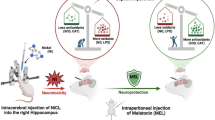Summary
The kynurenine pathway intermediate 3-hydroxyanthranilic acid (3-HANA) is converted by 3-HANA 3,4-dioxygenase (3-HAO) to the putative neuropathogen quinolinic acid (QUIN). In the present study, the neuroprotective effects of the 3-HANA analogue and 3-HAO inhibitor NCR-631 was investigated using organotypic cultures of rat hippocampus. An anoxic lesion was induced by exposing the cultures to 100% N2 for 150 min, resulting in a pronounced loss of pyramidal neurons, as identified using NMDA-R1 receptor subunit immunohistochemistry. NCR-631 provided a concentration-dependent protective effect against the anoxia. NCR-631 was also found to counteract the loss of pyramidal neurons in two models of neuroinflammatory-related damage; incubation with either LPS (10 ng/ml) or IL-1β (10 IU/ml). The findings suggest that NCR-631 has neuroprotective properties and that it may be a useful tool to study the role of kynurenines in neurodegeneration.
Similar content being viewed by others
Abbreviations
- EAA:
-
excitatory amino acid
- 3-HANA:
-
3-hydroxyanthranilic acid
- 3-HAO:
-
3-hydroxyanthranilic acid 3,4-dioxygenase
- IL-1β :
-
interleukin-1β
- KYNA:
-
kynurenic acid
- LPS:
-
lipopolysaccaride
- NCR-631:
-
4,6-dibromo-3hydroxyanthranilic acid
- NMDA:
-
N-methyl-d-aspartate
- QUIN:
-
quinolinic acid
References
Alberati-Giani D, Ricciardi-Castagnoli P, Köhler C, Cesura AM (1996) Regulation of the kynurenine metabolic pathway by interferon-γ in murine cloned macrophages and microglial cells. J Neurochem 66: 996–1004
Blight AR, Cohen TI, Saito K, Heyes MP (1995) Quinolinic acid accumulation and functional deficits following experimental spinal cord injury. Brain 118: 735–752
Foster AC, White RJ, Schwarcz R (1986) Synthesis of quinolinic acid by 3-hydroxyanthranilic oxygenase in rat brain tissue in vitro. J Neurochem 47: 23–30
Giulian D, Vaca K, Corpuz M (1993) Brain glia release factors with opposing actions upon neuronal survival. J Neurosci 13: 29–37
Heyes MP, Quearry BJ, Markey SP (1989) Systemic endotoxin increases L-tryptophan, 5hydroxyindoleacetic acid, 3-hydroxykynurenine and quinolinic acid content of mouse cerebral cortex. Brain Res 491: 173–179
Heyes MP, Saito K, Crowley J, Davies LE, Demitrak MA, Der M, Dilling L, Kruesi MPJ, Lackner A, Larsen SA, Lee K, Leonard H, Markey SP, Martin A, Milstein S, Mouradian MM, Pranzatelli MR, Querry BJ, Salazar A, Smith M, Straus SE, Sutherland T, Swedo S, Tourtellotte WW (1992) Quinolinic acid and kynurenine pathway metabolism in inflammatory and non-inflammatory neurological disease. Brain 115: 1249–1273
Heyes MP, Saito K, Major EO, Milstein S, Markey SP, Vickers JH (1993) A mechanism of quinolinic acid formation by brain in inflammatory neurological disease: attenuation of synthesis from L-tryptophan by 6-chloro-tryptophan and 4-chloro-3-hydroxyanthranilate. Brain 116: 1425–1450
Lapin IP (1978) Stimulant and convulsant effects of kynurenines injected into brain ventricles in mice. J Neural Transm 42: 37–43
Luthman J, Vdnerman E, Fredriksson G, Fornstedt-Wallin B (1996) Regulation of quinolinic acid in the normal rat brain by kynurenine pathway precursors. In: Allegri Filippini G, Costa CVL, Bertazzo A (eds) Recent advances in tryptophan research. Plenum Press, New York, pp 229–239
Malherbe P, Köhler C, Da Prada M, Lang G, Kiefer V, Schwarcz R, Lahm H-W, Cesura AM (1994) Molecular cloning and functional expression of human 3-hydroxyanthranilic-acid dioxygenase. J Biol Chem 269: 13792–13797
Nakagawa Y, Asai H, Kitoh J, Mori H, Nakano K (1995) Increases in the level of mRNA for 3-hydroxyanthranilate 3,4-dioxygenase in brain of epilepsy-prone IL mice. Biosci Biotech Biochem 59: 2191–2192
Rios C, Santamaria A (1991) Quinolinic acid is a potent lipid peroxidant in rat brain homogenate. Neurochem Res 16: 1139–1143
Rothwell NJ (1991) Functions and mechanisms of interleukin-1 in brain. TIPS 12: 430–435
Saito K, Markey SP, Heyes MP (1994) 6-Chloro-D,L-tryptophan, 4-chloro-3-hydroxyanthranilate and dexamethasone attenuate quinolinic acid accumulation in brain and blood following systemic immune activation. Neurosci Lett 178: 211–215
Saito K, Nowak TS, Markey SP, Heyes MP (1993) Mechanism of delayed increases in kynurenine pathway metabolism in damages brain regions following transient cerebral ischemia. J Neurochem 60: 180–189
Schurr A, Rigor BM (1993) Quinolinate potentiates neurotoxicity of excitatory amino acids in hypoxic neuronal tissuein vitro. Brain Res 617: 76–80
Schwarcz R, Whetsell WO, Mangano REM (1983) Quinolinic acid: an endogenous metabolite can produce axon sparing lesions in rat brain. Science 219: 316–318
Stone TW (1993) Neuropharmacology of quinolinic and kynurenic acids. Pharmacol Rev 45: 310–379
Studer L, Spenger C, Luthman J, Seiler RW (1994) NGF increases neuritic complexity of cholinergic interneurons in organotypic cultures of neonatal rat striatum. J Comp Neurol 340: 281–296
Todd WP, Carpenter BK, Schwarcz R (1989) Preparation of 4-halo-hydroxyanthralinates and demonstration of their inhibition 3-hydroxyanthralinate oxygenase activity in rat and human brain tissue. Prep Biochem 19: 155–165
Whetsell WO, Schwarcz R (1989) Prolonged exposure to submicromolar concentrations of quinolinic acid causes excitotoxic damage in organotypic cultures of rat corticostriatal system. Neurosci Lett 97: 271–275
Author information
Authors and Affiliations
Rights and permissions
About this article
Cite this article
Luthman, J., Radesäter, A.C. & Öberg, C. Effects of the 3-hydroxyanthranilic acid analogue NCR-631 on anoxia-, IL-1β- and LPS-induced hippocampal pyramidal cell lossin vitro . Amino Acids 14, 263–269 (1998). https://doi.org/10.1007/BF01345273
Received:
Accepted:
Issue Date:
DOI: https://doi.org/10.1007/BF01345273




